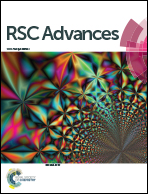Facile approach to design a stable, damage resistant, slippery, and omniphobic surface†
Abstract
Creating a robust omniphobic surface that repels various liquids would have broad technological implications for areas ranging from biomedical devices and fuel transport to architecture. The present omniphobic surfaces still have the problems of complex fabrication methods, high cost, and being environmentally harmful. To address these challenges, here we report a novel process to design a non-fluorinated, long-term slippery omniphobic surface of candle soot nanoparticles with a silicone binder that cures at room temperature. The porosity, nanoscale roughness, strong affinity of the substrate with the silicone lubricant, and retention of lubricant after curing of the binder play an important role in its stability and low ice adhesion strength at sub-zero temperature. The developed surface exhibits damage resistant slippery properties, repellency to several liquids with different surface tensions including blood, delay in freezing point along with ultra-low ice adhesion strength (2 kPa) and maintains it even below 7 kPa under harsh environmental conditions; 90 frosting/defrosting cycles at −90 °C; 2 months under an ice layer; 2 months at 60 °C; 9 days flow in acidic/basic water and exposure to super-cold water. In addition, this novel technique is cheap, easy to fabricate, environmentally benign and suitable for large-scale applications.



 Please wait while we load your content...
Please wait while we load your content...